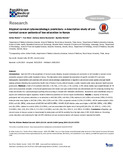Atypical cervical cytomorphologic predictors: a descriptive study of pre-cervical cancer patients of low education in Kenya.

View/
Date
2019-06Author
Muitta, Esther W.
Were, T.
Nyamache, A. K.
Metadata
Show full item recordAbstract
Background: Cervical cancer is a leading cause of cancer in women, accounting for 68% of cancer-related deaths among women in developing countries. Several reproductive, lifestyle and demographic risk factors are associated with increased risk for cervical cancer. This study examined the association of risk factors with precancerous cervical lesion grade in women attending Nakuru County Referral Hospital. Methods: This hospital-based, case-control study was conducted among women aged 20 to 70 years from January to December, 2017. A total of 142 women were recruited into the study and stratified based on precancerous cervical lesion grades based on the Bethesda System as: atypical glandular cells or adenocarcinoma in situ (AGC/AIS, n=8), high squamous intraepithelial lesions (HSIL, n=59), low squamous intraepithelial lesions (LSIL, n=35), and controls (n=40). Structured questionnaires were used to collect information on demographic, reproductive health, and lifestyle characteristics; anthropometric assessments were conducted. Endocervical swabs and scrapings were obtained from the study participants and used for HPV-16/18, and Pap smear screening. Results: Age differed significantly among the study groups, with age rising with higher grade of precancerous lesion. Higher rates of HPV-16/18 infection was associated with presenting with AGC/AIS (n=8, 100.0%), HSIL (n=47, 79.7%), and (n= 29, 82.9%), compared to controls (n=4, 10.0%; P< 86 cm was associated with higher risk of HSIL (AOR, 5.4; 95% CI, 1.9 to 15.4) and LSIL (AOR 2.9; 95% CI, 0.9 to 8.2). Having a healthy diet was associated with higher odds of LSIL (AOR, 4.2; 95% CI, 1.4 to 12.9), but was not associated with HSIL or AGC/AIS. Conclusion: This study suggests that HR HPV-16/18 infection, chronic lower abdominal pain with vaginal bleeding, and decreased upper and lower trunk body mass, are associated with higher risk of precancerous cervical lesions. Integrating targeted cervical cancer screening in routine reproductive health care services may reduce the risk of developing cervical cancer.
URI
http://hdl.handle.net/123456789/4606https://www.panafrican-med-journal.com/content/article/33/124/full/
https://www.panafrican-med-journal.com/content/article/33/124/pdf/124.pdf
https://pubmed.ncbi.nlm.nih.gov/31558923/
https://www.researchgate.net/publication/333864346_Atypical_cervical_cytomorphologic_predictors_a_descriptive_study_of_pre-cervical_cancer_patients_of_low_education_in_Kenya
https://www.unboundmedicine.com/medline/citation/31558923/Atypical_cervical_cytomorphologic_predictors:_a_descriptive_study_of_pre-cervical_cancer_patients_of_low_education_in_Kenya.
https://www.semanticscholar.org/paper/Atypical-cervical-cytomorphologic-predictors%3A-a-of-Muitta-Were/1271668db2175eb5c2a3e6ff677e252421cd1ca2
http://web.a.ebscohost.com/ehost/detail/detail?vid=0&sid=3a155034-6f35-428a-b31f-aac653e02120%40sessionmgr4006&bdata=JnNpdGU9ZWhvc3QtbGl2ZQ%3d%3d#db=a9h&AN=138998141
Collections
- Journal Articles (PAS) [285]
